March 2024
Special Focus: Petrochemical Technologies
Capture the full value of waste plastic pyrolysis oil through innovations in hydrocarbon analysis
Today, the world produces twice as much plastic waste as it did two decades ago, with the majority ending up in landfills, being incinerated or leaking into the environment.
Today, the world produces twice as much plastic waste as it did two decades ago, with the majority ending up in landfills, being incinerated or leaking into the environment. According to a report by the Organization for Economic Cooperation and Development (OECD), only 9% of this plastic is successfully recycled, and 22% of plastic waste is mismanaged.1
The report states that nearly half of all plastic waste is generated by the 37 countries that comprise the OECD. Plastic waste generated annually per capita varies from 221 kg in the U.S., to 114 kg in European OECD countries to 69 kg in Japan and Korea. Most plastic pollution comes from inadequate collection and the disposal of larger plastic debris known as macro plastics. Leakage of microplastics smaller than 5 mm in diameter from industrial plastic pellets, synthetic textiles, road markings and tire wear are a growing cause for concern.
Virgin—or primary—plastics made from crude oil or gas comprise most of today’s plastics production. While global production from recycled—or secondary—plastics has more than quadrupled from 6.8 MMt in 2000 to 29.1 MMt in 2019, this still represents only 6% of total global plastics production. Additional development is required to create a separate and sustainable market for recycled plastics, which are still considered substitutes for virgin plastic. Setting recycled content targets and investing in improved recycling technologies could help make secondary markets more competitive and profitable.
Mechanical and chemical recycling methods have gained considerable attention in recent years in the pursuit of reducing waste plastic generation, addressing serious environmental issues caused by plastic waste mismanagement and reducing the use of fossil fuels to produce fresh plastic. While mechanical recycling is still the main recycling method, chemical recycling is expected to become a significant means to achieve recycled plastic content targets by 2030.
This article reviews the chemical recycling method of pyrolysis to convert waste plastics into useful pyrolysis oil, a valuable feedstock for producing new plastics with a lower carbon footprint. The article also reviews the authors’ company’s development of a new analysis methodology to completely characterize the composition of waste process pyrolysis oil and harness its full potential as a plastic feedstock.
Pyrolysis pathways and stages
Pyrolysis is the primary reaction pathway for chemically recycling mixed plastic waste by converting it into valuable pyrolysis oil and gas. A thermal degradation process, pyrolysis heats the waste plastic in the absence of oxygen to break down the long polymer chains and, through a series of complex chemical reactions, recombine the smaller hydrocarbons into various products, including waste process pyrolysis oil (WPPO).
The process typically involves three stages:
- Initiation/melting: The plastic waste is heated to a specific temperature, where it begins to melt and decompose. Some plastics, such as polyvinyl chloride (PVC), degrade completely at this stage.
- Reaction/vaporization: The complete conversion of plastic melt releases vapors containing different types of hydrocarbons. The initial monomer/oligomer molecules undergo several molecular recombinations to produce a complex mix of hydrocarbons.
- Termination/condensation: The vapors are cooled rapidly to terminate any residual cracking and condense them into liquid form, resulting in pyrolysis oil. Any non-condensable gas remains as pyrolysis gas.
WPPO possesses several properties that make it an attractive alternative to conventional fossil fuels:
- Circular economy: WPPO can be utilized as a feedstock to produce more plastics, thereby contributing to the concept of a circular economy, reducing the need for virgin fossil fuels.
- Fuel potential: Pyrolysis oil has a high hydrogen content and can substitute for conventional fuels like diesel and gasoline after proper polishing.
- Landfill reduction: Converting waste plastic into pyrolysis oil reduces landfill disposal and ocean pollution caused by mismanaged microplastic.
- Resource recovery: Converting waste plastics into oil recovers valuable resources that would otherwise be lost as non-recyclable waste.
While WPPO holds significant promise, several challenges must be addressed:
- Quality and consistency: The quality of pyrolysis oil varies depending on the type of plastic and other contaminants found in the feed mix, as well as the pyrolysis conditions affecting its usability and applicability.
- Upgrading: Raw pyrolysis oil requires further processing or upgrading to meet specific standards for fuel or as feed for steam cracking to produce circular monomers.
- Environmental impact: The pyrolysis process requires significant energy input, which adds concerns about the environmental impact in terms of carbon dioxide (CO2) emissions.
- Regulation and standardization: Clear regulations and standards are necessary to ensure the safe production, distribution and use of WPPO.
Analytical innovations unlock pyrolysis oil’s potential
The authors’ company is actively working to address these challenges through ongoing technology innovations. For example, the company set up a partnershipa to develop an advanced pyrolysis process that utilizes the principle of thermal conversion to continuously produce pyrolysis oil and gas from a mixed plastic stream comprising PP, high- and low-density polyethylene (HDPE/LDPE), and some polystyrene.
Simultaneously, the authors’ company is working with industry partners to develop a comprehensive framework for characterizing, testing and applying pyrolysis oil—a framework that promises vital insights to researchers, industry professionals and policymakers seeking to harness the full potential of this fuel.
One of the greatest challenges in analyzing pyrolysis oil is determining its detailed chemical composition to differentiate the carbon number and hydrocarbon classes of all the compounds present. The current technology uses a well-established methodology that relies on the natural composition of crude oil and its derivatives. Nature provides familiar patterns from similar sources. Regardless of whether a crude sample was sourced from Nigeria or Saudi Arabia, it will contain similar analytical patterns that serve as a reference when analyzing naturally occurring fuels derived from that crude.
Such patterns do not exist in WPPO analysis since the oil is synthetically produced from polymer chains. Therefore, a new analysis methodology is required to characterize a pyrolysis oil’s chemical composition, physical properties, stability and impurities. A standardized characterization technique will enable effective quality control and facilitate comparisons across various sources and production processes.
The authors’ company has worked with gas chromatography–vacuum ultraviolet (GC-VUV) spectroscopy detector developers to reliably analyze complex pyrolysis oil and determine the carbon numbers and the classes of the compounds. Classic GC flame ionization detection depends on the elution order and a reference pattern to extrapolate the composition of the pyrolysis oil. However, the lack of pattern in WPPO makes it impossible for current analysis methods to correctly determine the proper compound classes. This results in such erroneous outcomes as aromatics being mistaken for olefins and paraffins being misidentified.
VUV renders an additional layer of assessment by providing a spectral analysis of each component as it eludes the gas chromatogram. TABLE 1 compares a typical WPPO between detailed hydrocarbon analysis (DHA) and vacuum ultraviolet hydrocarbon analysis (VHA). VHA is a modern approach to DHA that uses VUV spectroscopy and spectral validation to deconvolve and identify critical components accurately and without human intervention, and in a fraction of the time of traditional DHA.
The difference between the results is significant. GC-VUV offers a simplified, affordable analytical tool that can analyze normal paraffins, isoparaffins, aromatics, naphthenes and olefins with greater accuracy.
Early results prove promising
VUV analysis was performed on multiple light pyrolysis oil fraction samples (at 750°F) generated from a commercial plant processing HDPE/LDPE/PP (both rigid and film) (FIGS. 1–5). The following are characteristics of typical pyrolysis oil:
- A considerable amount of olefins are present and distributed throughout the carbon chain in light pyrolysis oil.
- A considerable amount of normal paraffins are also present and similarly distributed.
- Isoparaffin is present more towards the C15–C16 carbon number.
- The aromatics content in pyrolysis oil is low and mostly found in the C6–C9 range, making them mostly mono-aromatics.
- Sample figures show the aromatic species as primarily C8. The light oil is low on Di+ aromatics, which typically means extremely low peptide nucleic acid (PNA) formation and subsequent coking tendency during catalytic or steam cracking.
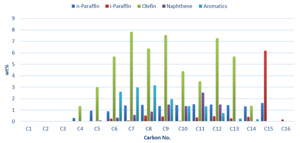
By providing a more detailed understanding of the nature of the pyrolysis oil, VUV helps estimate the possible yield structure from a steam cracker, downstream hydroprocessing or fluid catalytic cracking (FCC) type units.
The authors’ company is also working with the ASTM D02.P Recycle Product subcommittee to develop an industry standard guide for the basic analytical needs for WPPO. By establishing a common ground for the development of WPPO, the guide will help the industry further enhance WPPO’s composition and how it can be best used in different industries. The mutual benefit will be building on the strength of WPPO toward more environmentally friendly solutions.
TABLE 2 presents some of the basic analytical methodologies that will be covered in the ASTM guide to WPPO.
Takeaway
As the world seeks sustainable alternatives to traditional energy sources, WPPO stands out as a remarkably innovative technology that offers a way to alleviate the burden of plastic waste and produce a versatile energy source with reduced emissions. By harnessing the potential of this oil, societies can simultaneously address the plastic waste crisis and move toward a more sustainable and circular economy. The first step is accurate and thorough analyses of the WPPO. This will convert to more reliable process technology and improved advancements in analytical techniques for WPPO. HP
NOTE
a Lummus Technology and New Hope Energy
LITERATURE CITED
1 OECD, “Plastics pollution is growing relentlessly as waste management and recycling fall short, says OECD,” February 2, 2022, online: https://www.oecd.org/environment/plastic-pollution-is-growing-relentlessly-as-waste-management-and-recycling-fall-short.htm



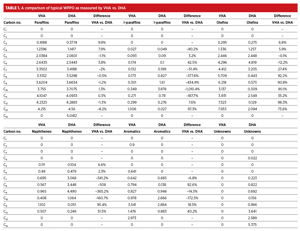
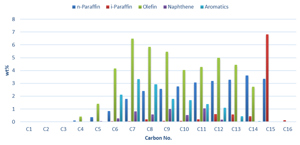
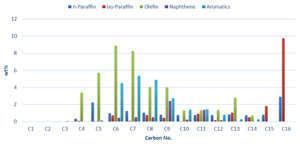
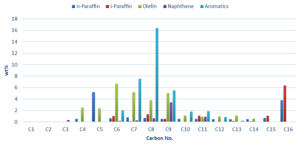
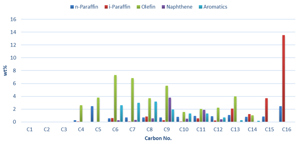
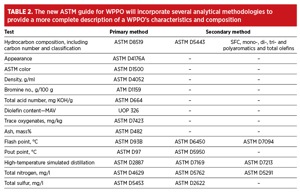





Comments